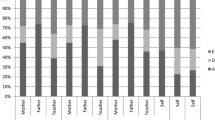Abstract
This exploratory study seeks to better understand possible relationships between environmental factors, locus of control, and suicide risk among adolescents. The data derive from in-school surveys of eight-grade students conducted in 1998 and 1999 in Arizona, California, Nevada, and Wyoming. Results revealed higher levels of suicide risk were associated with a more external locus of control orientation. Relationships between suicide risk and several environmental factors and preferences also were found. Potential links between locus of control, environment, and suicide risk are discussed, as are implications for intervention efforts and future research.
Similar content being viewed by others
References
Anderson, R. N. (2002). Deaths: Leading causes for 2000 (DHHS Publication No. 2002–1120), Hyattsville, MD: National Center for Health Statistics
Asarnow J. R., (1992), Suicidal ideation and attempts during middle childhood: Associations with perceived family stress and depression among child psychiatric inpatients Journal of Clinical Child Psychology 21:35–40
Beautrais, A.L., Joyce, P.R., & Mulder, R.T. (1999). Personality traits and cognitive styles as risk factors for serious suicide attempts among young people. Suicide and Life Threatening Behavior, 29(1), 37-47
Benard B., (1991). Fostering resiliency in kids: Protective factors in the family, school, and community. Western Center for Drug-free Schools and Communities, Portland, OR
Blumenthal S. J., (1998). Suicide: A guide to risk factors, assessment, and treatment of suicidal patients Medical Clinics of North America 72:937–971
Canetto S. S., Sakinofsky I., (1998). The gender paradox in suicide Suicide and Life – Threatening Behavior 28:1–23
Centers for Disease Control, Prevention, (1995). Youth risk behavior surveillance – United States 1993, Morbidity and Mortality Weekly Report 44:1–55
Centers for Disease Control, Prevention, (2002). Youth risk behavior surveillance – United States 2001, Morbidity and Mortality Weekly Report 51:1–64
Clark C., Uzzell D. L., (2002). The affordances of the home, neighbourhood, school and town centre for adolescents Journal of Environmental Psychology 22:95–108
Cohen Y., Spirito A., Brown L. K., (1996). Suicide and, suicidal behavior. In R. J. DiClemente, W. B. Hansen, (Eds), Handbook of adolescent health risk behavior: Issues in clinical child psychology. Plenum Press, New York, NY 193–224
Coulton C. Korbin J. E., Su M., Chow J., (1995). Community level factors and child maltreatment rates Child Development 66:1262–1276
De Wilde E., Kienhorst I. C. W. M., Diekstra R. F. W., Wolters W. H. G., (1993). The specificity of psychological characteristics of adolescent suicide attempters Journal of American Academy of Child and Adolescent Psychiatry 32:51–59
Ernst J. S., (2001). Community-level factors and child maltreatment in a suburban county Social Work Research 25:133–142
Evans W. P., Marte R. M., Betts S., Silliman B., (2001) Adolescent suicide risk and peer-related violent behaviors and victimization Journal of Interpersonal Violence 16:1330-1348
Francis C., Cooper C., (1991). Places people take their problems. In J. Urbina-Soria, P. Ortega-Andeane, R. Bechtel, (Eds), EDRA 22: Healthy environments. Environmental Design Research Association 178–184
Gould M. S., Shaffer D., Fisher P., Kleinman M., Morishima A., (1992). The clinical prediction of adolescent suicide. In R. W. Maris, A. L. Berman, (Eds), Assessment and prediction of suicide. Guilford Press, New York, NY 130–143
Kaplan R., Kaplan S., (1989). The experience of nature: A psychological perspective. Cambridge University Press, Cambridge
Kaplan S., (1995). The restorative benefits of nature: toward an integrative framework Journal of Environmental Psychology 15:169–182
Korpela K., Hartig T., (1996). Restorative qualities of favorite places Journal of Environmental Psychology 16:221–233
Kuo F. E., Sullivan W. C., (2001). Aggression and violence in the inner city: Effects of environment by mental fatigue Environment & Behavior 33:543–571
Lawson L., McNally M., (1995). Putting teens at the center: Maximizing public utility of urban space through youth involvement in planning and employment Children’s Environments 12:209–221
Miller K. E. King C. A., Shain B. N., Naylor M. W., (1992). Suicidal adolescents’ perceptions of their family, environment Suicide and Life – Threatening Behavior 22:226–239
Minino, A. M., & Smith, B. L. (2001). Deaths: Preliminary data for 2000 (DHHS Publication No. 2001–1124). Hyattsville, MD: National Center for Health Statistics
Nelson P. A., Singg S., (1998). Locus of control, sex, and attitudes toward suicide Psychological Reports 83:353–354
Nowicki S., Jr., Strickland B. R., (1973). A locus of control scale for children Journal of Consulting and Clinical Psychology 40:148–154
Owens P. E., (1988). Natural landscapes, gathering places, and prospect refuges: Characteristics of outdoor places valued by teens Children’s Environments Quarterly 5:17–24
Perez-Smith A., Spirito A., Boergers, J., (2002). Neighborhood predictors of hopelessness among adolescent suicide attempters: Preliminary investigation Suicide and Life – Threatening Behavior 32:139–145
Perkins D. F., Hartless G., (2002). An ecological risk-factor examination of suicide ideation and behavior of adolescents Journal of Adolescent Research 17:3–26
Peters, K. D., Kochanek, K. D., & Murphy, S. L. (1998). Deaths: Final data for 1996 (DHHS Publication No. 99–1120). Hyattsville, MD: National Center for Health Statistics
Ross C. E., (2000). Neighborhood disadvantage and adult depression Journal of Health and Social Behavior 41:177–187
Taylor A. F., Kuo F. E., Sullivan W. C., (2001). Coping with ADD: The surprising connection to green play settings Environment & Behavior 33:54–77
Ulrich R. S., (1984). View through a window may influence recovery from surgery Science 224:420–421
Ulrich R. S., Simons R. F., Losito B. D., Fiorito E., Miles M. A., Zelson M., (1991). Stress recovery during exposure to natural and urban environments Journal of Environmental Psychology 11:201–230
U.S. Public Health Service, (1999). The surgeon general’s call to action to prevent suicide. Department of Health and Human Services, Washington, DC
Author information
Authors and Affiliations
Corresponding author
Additional information
William P. Evans and Shawn C. Marsh are affiliated with the University of Nevada, Reno. Pasty Owens is affiliated with the University of California, Davis.
Rights and permissions
About this article
Cite this article
Evans , W.P., Owens, P. & Marsh, S.C. Environmental Factors, Locus of Control, and Adolescent Suicide Risk. Child Adolesc Soc Work J 22, 301–319 (2005). https://doi.org/10.1007/s10560-005-0013-x
Published:
Issue Date:
DOI: https://doi.org/10.1007/s10560-005-0013-x




